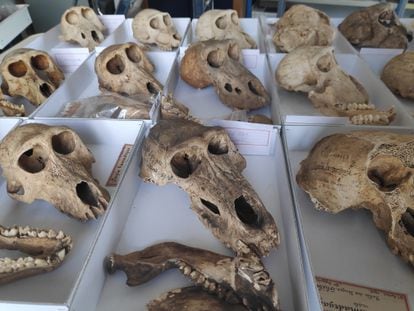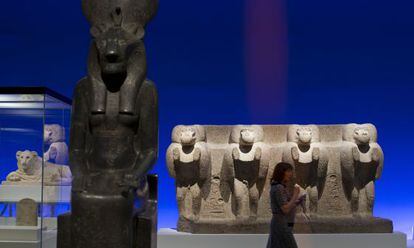Ancient Egyptians worshipped animals, but mummies show they weren't well cared for
A study on mummified baboons found diseases like rickets and deformities due to poor nutrition and lack of sunlight


The ancient Egyptians had such a profound fascination with animals that even the Romans found it amusing. Roman poet Juvenal wrote in Satires: "Who knows not, O Volusius, what monsters demented Egypt worships? One city adores the crocodile, another venerates the ibis that gorges itself with snakes… In one town, cats are worshiped, in another a river fish, and in another they venerate a dog."
Even though they were sacred, the Egyptians didn't care for the animals well. To understand how they lived, we need to visit Saqqara, a large necropolis located approximately 18 miles (30 kilometers) south of Cairo. During Egypt's Old Kingdom period (2700–2200 B.C.), Saqqara served as an important religious and funerary site. It housed tombs and temples dedicated to various deities, including specific sanctuaries for millions of sacred animals.
Archaeological studies are now revealing the living conditions of these animals. For instance, the presence of diseases and fractures in mummified dog bones indicates that they were kept in small spaces and lacked proper care. Animals were raised on a large scale and slaughtered to meet the high demand for animal mummies. The provisioning and maintenance of animals likely played a significant role in the city's economy.
Saqqara became a center for the ritual sacrifice of animals to mummify and place in tombs and temples. This would guarantee divine protection and eternal life for the deceased. Special priests performed the sacrifice, mummification and burial process.
However, Saqqara was not the sole location for these practices. A recent study published in PLoS One journal analyzed the bones of 36 baboons discovered at the Gabbanat el-Qurud archaeological site near the ancient city of Thebes. The findings were clear — these baboons lived hard lives. The bones belonged to baboons of various ages from two species: the hamadryas baboon (Papio hamadryas) and the olive baboon (Papio anubis). Unlike other mummified animals, wild baboons were not native to Egypt, indicating that they were imported and raised there.
/cloudfront-eu-central-1.images.arcpublishing.com/prisa/MUSQARQT55G5DIYLWFGWWOWCJE.jpg)
The olive baboons were brought from the south (modern-day Sudan) and transported down the Nile River. Hamadryas baboons came from the Arabian Peninsula and were brought across the Red Sea and desert roads. These are the known transportation routes, although the exact origins of the baboons are still debated.
Interestingly, bone analysis enabled scientists to distinguish between baboons born in the wild from those born in captivity. An intriguing example is the female hamadryas baboon, whose bones exhibited only one physical problem: a tooth cavity and poor mineralization of bone enamel, also known as enamel hypoplasia. This condition is commonly observed in wild animals that have been captured and experience high levels of stress. The researchers concluded that the baboon was captured at the age of two and died at the age of eight.
However, baboons born in captivity had a different story to tell. Almost all of their bones exhibited osteoarthritis, rickets, poorly developed teeth, deformed limbs and faces, and other metabolic diseases. The reasons are simple: poor nutrition and lack of sunlight. The study gives us an understanding of the severe living conditions these animals endured. It's possible that the reality was even worse, as bones don't contain traces of every disease.
Since baboons are aggressive animals and skilled climbers, the study concluded that their captors likely kept them in buildings or high-walled enclosures. Instead of their varied natural diet, these baboons were likely fed table scraps like stale bread.
Neglectful harm
There were no indications of physical abuse of the baboons, and the study authors firmly believe that they were not intentionally mistreated. Salima Ikram, a professor of Egyptology from the American University of Cairo who was not involved in the research, told CNN: "Unfortunately, the Egyptians did not know enough about the care and feeding of baboons. While trying to give them reverence and care, they actually established conditions detrimental to the health and well-being of the animals — the way to hell is paved with good intentions!"

In Ancient Egypt, animals were believed to possess supernatural powers that gave them a special connection to the gods. These beliefs formed the foundation of their religious practices. Animals were associated with specific deities, sharing their attributes and strengths. Notably, the gods of the ancient Egyptians were characterized as having both human and animal traits, a concept known as theriomorphism.
Cats were associated with Bastet, the goddess of love, beauty and self-indulgence. Dogs and other carnivorous canids were connected with Anubis, the god of cemeteries, embalming, and travel. Birds of prey, known for flying high in the sky, were associated with the Sun god. The sacred ibis, with its beak resembling a reed pen, represented Thoth, the god of writing and wisdom.
It was believed that each god could appear as an animal during its lifetime, and after its death, the spirit of the god would be transferred to another animal of the same species. These animals were mummified and buried in tombs with great ceremony. The ancient Egyptians mummified millions of animals, including cats, dogs, foxes, jackals, mongooses, sheep, goats, gazelles, shrews, monkeys, rodents, snakes, crocodiles, lizards, fish, birds of prey, ibis, and scarab beetles still in their dung.
One significant aspect of Egyptian religious beliefs was the use of live animals to connect with the deities. This provided a more accessible means of worship compared to the representations of gods confined in their temples. This democratization of religion fostered a closer relationship between people and the gods through animals, contributing greatly to the success of these cults.
Sign up for our weekly newsletter to get more English-language news coverage from EL PAÍS USA Edition
-- Sent from my Linux system.
No comments:
Post a Comment